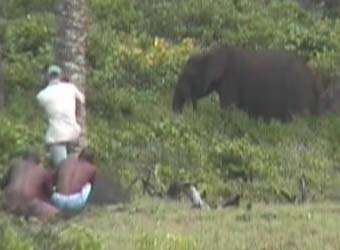About a walk along a beach on the equator
In the 16th century the kingdom of Loango covered a large part of what is now south-west Gabon and stretched to the mouth of the River Congo. But this is not what our guide, Armell, meant when he said "C'est le royaume ici" ("This is a kingdom here"). We stopped and looked at the orange sun sinking into the sea. Armell commented while lying against a tree and making a wide gesture with his arms, while to our left on the savannah a family of elephants were grazing and to the right in the distance we could see buffalo.
The day began at 6 a.m. with a hiss as Fons' mattress was being rolled up. This was also the signal for me to do something. On an ambitious day we delayed breakfast. We departed well before seven o'clock, because even by eight o'clock you can feel the heat of the sun and we look for a new camp site about ten o'clock. In this way, with the necessary breaks, we covered 6 or 7 km. Today we have covered more distance because there was no shade or water when we first wanted to stop. Then a wood fire, camp and coffee followed quickly. There just remained the loud roar of the sea. The surf here is spectacular.
Late in the afternoon our rest was disturbed by noises in the undergrowth next to our tents. A male elephant was venturing carefully onto the savannah. Fons headed towards it, Armell and Zico close behind (they take their task very seriously, tourists must be kept safe). Below left you can see what this looked like. A while later mother and baby appeared from the right, heading for the same palm tree. For a moment it looked like a sticky situation, but elephants are short-sighted and in addition cannot see immediately in front of themselves. Eventually everyone started to move, the elephants into the jungle and the two-footers towards their camp.

|
|
Fons, Zico and Armell stalk the male
|
|
|

|
|
a resulting photo
|
|
A week ago, accompanied by two WWF eco-guides, Fons and I left Gamba by boat with the objective of starting to walk at Sette Cama and take two weeks to reach Iguela. We gave ourselves the opportunity and time to enjoy the completely empty beaches and to meet or track any wild animals we might come across.
We brought most of our food in dried form from the Netherlands so we could walk with light packs. We made two meals a day with this (the fire burns low all night). It took some difficulty to explain to the boys that this gave edible, complete meals. With macaroni or rice based food for the evening meal that succeeded. We tried to tempt them with muesli-type breakfast as 'Quakers' oatmeal but they were not interested. They supplemented the meals with crabs they caught, cooked and ate. And of course we fished.
In Tassi we unexpectedly came across a "lodge" under construction. This gave us an insight into the other way to experience the Loango National Park: Operation Loango. For those who have little time but do have money, this is a comfortable form of safari in Loango. Our route could have easily been covered in about 10 days, without setting high demands on physical condition.

|
|
red river hog's
|
|
|

|
|
Armell and Mathon with a 'lost soul', i.e. a leatherback-turtle that could not find its way back to the sea as all the others had done the night before
|
|
And this is how Fons stalks an elephant .....
|
|
|
